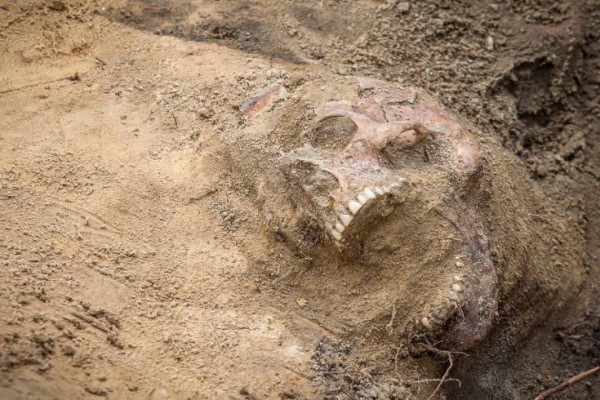Notes
On any Given Day, What May be Needed is Not 400 Photographs, But Just 1
Let’s start with one photo.
The caption reads, “Human remains are seen during the exhumation of a Stalinist-era mass grave on the military cemetery in the heart of the Polish capital Warsaw. The grave is believed to contain the remains of around 200 victims of a post-war campaign of communist terror.”
Perhaps the victim was screaming at the moment of death, but the gaping jaw could be an accident of decay or excavation. Perhaps the lost individual will be identified, and perhaps the family can be notified. Perhaps the remains will have forensic value, and maybe some remnant of justice can yet be done.
But, OMG, what an image. The accidents of time have produced a howling, shrieking cry of pain and rage. The body emerging from the earth is still shrouded with dust, as if still more ghost than material thing. The immobility of being long buried is still binding the corpse, but it seems to be straining to be released, to rise up in glorious, savage revenge. A revenge that will never come, as instead it will be interned again in a bureaucratic process constrained by a decided imbalance of power.
And so it has to settle for a more academic symbolism: there lies The Past, or Terror, or the Human Condition. These are not small things, but they can have other emblems as well. Yet, even so, I can’t help but think–or hope–that this image might haunt whatever idea is brought to it; that it might arise again in the night or at an odd moment, and that it might disturb, trouble, bring one perhaps to tremble for this lost soul from history’s slaughter pen.
OK, and now add a million more photos. Start with the 10,000 that were sent to photo editors on the day this one was published. Add another 10,000 for the many days before and every day after that. Add also all the other images that you see every day in the news, advertising, and entertainment, and on Facebook, Flickr, and other social media. Then add in what everyone else is seeing: the 200,000 photos that are uploaded to Facebook every minute, and the 27,00 at Instagram, etc. And while you are at it, drop by a museum and see an exhibition of photographs.
Were you to do any of this, you might feel like Chloe Pantazi, who went to an exhibition at the Brooklyn Museum on war photography. Pantazi came away feeling “numb,” as if she had been anesthetized, and, not surprisingly came to the conclusion that “Susan Sontag Was Right” when she condemned photographs for dulling our ethical capacity. Well, even a stopped clock is right twice a day, so I guess it could happen, but the declaration also provides an opportunity to think for a few seconds and say, “Really?”
I haven’t seen the exhibition, nor do I doubt for a minute that Pantazi had the experience she reports, so we need not disagree about her review on those terms. That said, Pantazi’s reaction is not surprising for several reasons: First, it is a very understanding reaction to over 400 photographs about war taken in a single experience of dedicated viewing. Indeed, I would expect the same result from reading 400 essays, or 400 pages, on the horror of war. What most of us would not do in that case, however, is conclude that words were the problem. And yet that is the point of the photography review, as the subtitle declares: “A troubling new exhibit at the Brooklyn Museum of Art throws into question the medium’s very purpose.”
Which leads to the second reason her conclusion is so familiar: it is exactly the reaction one is primed to have after reading Sontag, not to mention John Berger, Allan Sekula, Martha Rossler, and others who have crafted the conventional discourse of photography theory along the same line. (See the first chapter of Susie Linfield’s The Cruel Radiance for a provocative exposition on this point.) What might be a normal–and temporary–reaction to intensive consumption of any medium becomes redefined as a universal failing of a single medium. Once primed to be misused and disappointed by photography, it is easy to code one’s experience accordingly. Let me add that putting the exhibition in a museum doesn’t help, as the fine arts context dominant there (as it is in Sontag’s work) interferes with correctly understanding a public art.
Again, the point here is not to reprove Pantazi for what might be a spot on review of a flawed exhibition. But her reaction, the size of the exhibition, and even Sontag’s interpretative biases all point toward what is a very real condition of the image world today: excess. And where there is excess, there will be exhaustion.
And as Pantazi rightly assumes (more so than the early Sontag, by the way), the emotions that come to be exhausted by images of horror are crucial for moral response, reflection, and engagement. So this is no small problem. But if we could set aside Sontag’s censorious tone, it is a problem that could lead to many creative solutions.
I’m out of time tonight, but let me close by suggesting that there is much more to excess than the likelihood of overwhelming us. (And be sure to see David Campbell’s corrective argument about the much more manageable circumstances of actual practice.) Indeed, photography as always been an abundant art: cheap, expansive, and ending up in every corner of the world. (I have a bit more to say on rethinking abundance here and here.) What does need to be done is to take more seriously the curatorial function, which includes not only actual curators or editors, but also critics and citizens as they sort, select, and share images as part of their participation in the virtual world of public culture.
And we need to remember that at the end of any given day, what may be needed is not 400 photographs, but just one. Like the one above, for example.
— Robert Hariman
(cross-posted from No Caption Needed)
(photo: Wojtek Radwanski/AFP-Getty Images)



Reactions
Comments Powered by Disqus